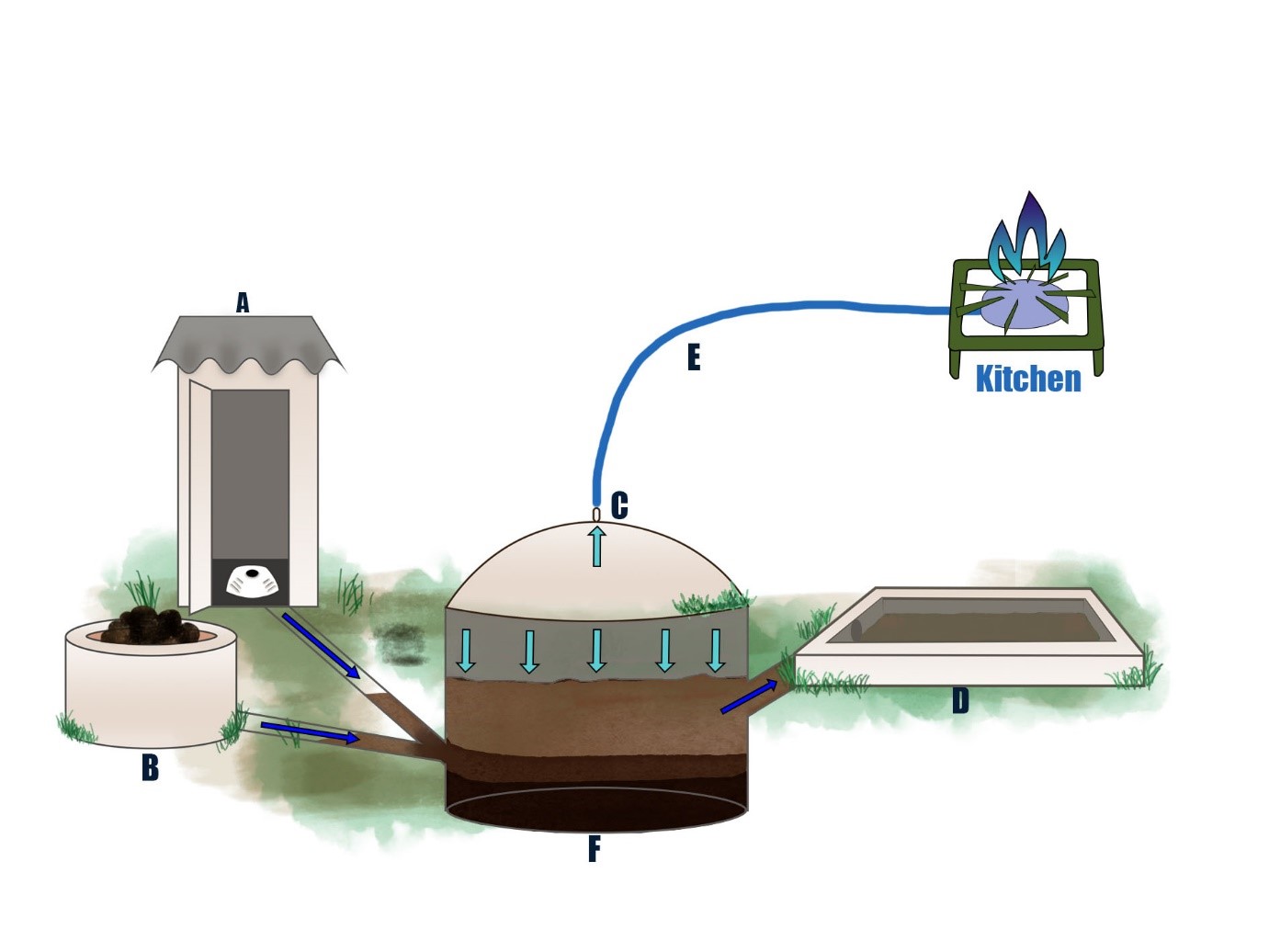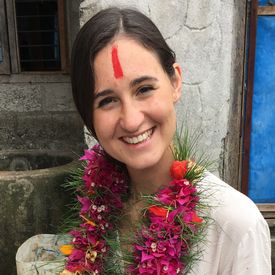Cultural taboos are often described as an insurmountable barrier to adoption of domestic toilet-linked anaerobic digesters (TLADs). This study provides a better understanding of the socio-cultural resistance towards TLADs through findings from interviews with households in Assam, and demonstrates that this resistance can be negotiable in certain circumstances. It highlights various pathways to adoption of TLADs and suggests ways in which the implementation of the national biogas programmes could become more effective.
Inadequate sanitation is estimated to cause 432,000 diarrhoeal-related deaths annually, and is linked to the transmission of many waterborne and bacterial diseases such as cholera, hepatitis A, typhoid and polio. At the same time, high levels of indoor air pollution – caused by the burning of wood, crop wastes and dung in open fires, and inefficient stoves used for cooking – are estimated to cause up to four million premature deaths from associated illnesses.
Domestic toilet-linked anaerobic digesters (TLADs) are structures which recycle organic household waste streams such as animal dung (mainly cow or pig dung) along with food waste, agricultural waste and human excreta, into a gaseous fuel – biogas – and an organic fertiliser by-product called slurry. When a household toilet is connected to an anaerobic digester, households can benefit from an improved sanitation system and increased biogas production. This domestic biogas can replace or reduce the use of unsustainable and polluting fuels. Additionally, even though it is possible that TLADs will not remove all pathogens, users can be trained to safely handle and treat slurry through composting with other organic materials and drying (World Health Organization, 2006).
Figure 1 illustrates the functioning of a TLAD: the feedstock from the toilet (A) and the cow/animal dung and other organic waste inlet (B) flow into the digester (F) after mixing with water. Domestic digesters do not produce adequate biogas for a family’s needs using only human excreta, and so it is co-digested with other feedstocks (Boyd Williams et al., 2022). As the organic waste decomposes, biogas builds up inside the digester and flows through a pipe (E) directly to the kitchen stove through a pressure gradient. The production of biogas increases the pressure inside the fixed dome structure (C) and forces the by-product of the process (a nutrient rich and predominantly liquid slurry, which can be used as a plant fertiliser) out and into the slurry storage area (D). Typically, (C) is all that can be seen above ground, though in some cases both (F) and (C) are buried underground.
Figure 1: Illustration of a fixed dome TLAD

Source: Boyd Williams et al. (2022).
Note: Dark blue arrows depict the flow of feedstock, and light blue arrows depict the flow of biogas.
Efforts to implement domestic biogas technology
In India, the nationwide domestic biogas programme began in the early 1980s, and still operates today within the Ministry of New and Renewable Energy (MRNE) under the name the New National Biogas and Organic Manure Programme (NNBOMP). Its main policy objectives are to provide clean cooking fuels and reduce the drudgery of women who predominantly collect the firewood and cook over smoky hearths; provide organic fertilisers and reduce dependency on chemical fertilisers; and improve sanitation in rural areas. Subsidies and financial assistance are provided by the MNRE through a top-down model (Mittal et al. 2018) and assigned to each state.
However, it is estimated that only a little more than 5 million domestic biogas units have been installed, against the potential target of 12 million. Implementation and use of domestic biogas technology has not been encouraging in recent times. In some instances, up to 60% of installed biogas digesters are abandoned or have broken due to various socio-technical reasons (Dutta et al. 1997). Many of these issues are technical, including poor construction, inadequate or absent follow-up services, and lack of user-training. Inadequate biogas production is often due to inadequate feedstock, as well as poor technical knowledge of users and the high failure rate of biogas often creates a negative perception of biogas that discourages potential future users (Mittal et al. 2018). Resistance can also arise due to socio-cultural reasons such as apprehension about using human excreta and animal dung derived products (Raha et al. 2014, Mittal et al. 2018). Handling and reusing excreta in India is associated with cultural taboos (Burt et al. 2021).
Despite the Indian Government offering an additional subsidy to households that connect a household toilet to a biogas unit, there are very few reports of successful adoption that can counter the more prolific reports of socio-cultural rejection (Raha et al. 2014, Muralidharan 2017, Mittal et al. 2018). Despite examples of the successful uptake of TLADs both within India (Kharbanda and Qureshi 1985, Estoppey 2010, Jha 2014), and in other Asian countries (Bajgain and Shakya, 2005, Cheng et al. 2011, Huong et al. 2014, Boyd Williams et al. 2022), the socio-cultural resistance towards TLADs in India has remained largely unexplored within research and is poorly understood.
It is unknown if and how socio-cultural resistance varies temporally and spatially, and thus existing literature cannot explain why it can be overcome in some places, but not others. For instance, in Nepal, despite the religious demographic and socio-cultural norms being similar to India’s, the acceptance of TLADs has been much higher (Bajgain and Shakya 2005, Boyd Williams et al. 2022). The aim of our research is to provide a more in-depth analysis of what socio-cultural resistance is and how it influences TLAD adoption, with the aim of better understanding local contexts and improve biogas implementation.
Understanding social perception of TLADs
Using a socio-technical lens, we analysed the narratives of 40 in-depth semi-structured household interviews from the state of Assam to obtain a better understanding of the perceptions people have of TLADs, and potential motivations for changing their attitudes towards TLADs. We also utilised an additional 60 semi-structured interviews to obtain a contextual overview of how Assam’s implementation of the biogas programme is supporting sustainable uptake of biogas technology and the connection of household toilets.
Agriculture and livestock farming play a significant role in the economy of Assam, suggesting the availability of ample biogas feedstock. However, in 2022, out of the 6.4 million households in Assam only approximately 2.16% (or 138,500 households) have installed domestic biogas facilities, and more broadly, only 42.1% of the population use clean fuels for cooking.
Our findings from the interviews crucially revealed that describing resistance towards TLADs as “socio-cultural rejection” has framed local opinion as resistant to technological change whilst ignoring diversity within groups. Resistance was sometimes found to be more socio-technical, where it was linked to how much people understood about TLADs and could possibly be overcome by providing opportunities to learn more about the technology. However, resistance was also sometimes independent of people’s understanding of TLADs – some people would feel the same about them no matter how much they learnt about the benefits.
Many people perceived TLADs as unnecessary due to the small amounts of human excreta a household produces compared to cattle dung, as well as the availability of alternative products and services (such as LPG). Resistance was also related to how orthodox an individual’s or group’s beliefs were around religious purity and pollution practices, and their willingness to risk the negative social consequences of adopting a TLAD.
Potential pathways to adoption of TLADs
Through our conversations with households, we also identified some potential pathways to increasing the adoption of TLADs:
i) Following leaders or risk-takers: We recognised that some participants had overall positive perceptions of TLADs, in addition to making decisions independent of social approval. They could become catalysts for community adoption of TLADs in Assam.
“Maybe some of them will not like it in the beginning. But if I get the opportunity then I will use it. Also, once the other people see that the fuel is benefitting me then they will also start using it” – 40 year-old Muslim woman
ii) Trialling or observing a TLAD: Some people felt they could not make decisions around TLAD adoption without first using one. Participants reflected that they might only feel disgusted because they are not familiar with TLADs, and with familiarisation they might reduce the feeling of disgust.
“In the beginning I will feel disgusting and dirty. But as time flows, I will be accustomed to handle it [slurry from TLAD]” – 55 year-old Hindu man
iii) TLADs becoming a social norm: This could result in them being perceived as less disgusting, and lead to more people adopting them.
“Toilet is something which we all feel disgusting. And gas from it… I don’t think I will prefer it now. If someday everyone is using it then I might become accustomed with it and start using it… It is kind of psychology. If everyone uses it then it becomes a kind of tradition” – 19 year-old Hindu man
iv) TLADs become perceived as a necessity: Participants explained that if they lacked access to other fuels (due to reasons such as rising prices), then they would have no choice but to use a TLAD.
“If the LPG price rises too high, then we shall use a TLAD connected to our gobar gas1 as we wouldn't be left with any other options. Such circumstances will compel us to do so!” – 64 year-old Hindu man
These potential pathways to TLAD adoption have perhaps not been worked into the region's biogas policy implementation plan. We found that many participants had heard of TLADs, but only one participant had been offered one and very few knew of the additional subsidies for TLADs. No one had had the opportunity to observe a TLAD being used in Assam, and there was no evidence that officials had engaged with or supported potential users in adopting TLADs. The absence and low awareness of TLADs could also be a result of a negative or dismissive attitudes towards TLADs from biogas programme actors themselves. Interestingly, two participants within the biogas programme organisation – a programme officer within the state and a biogas technician, who are gatekeepers to knowledge of biogas technology – had dismissive attitudes towards TLADs.
More generally, Assam’s biogas programme was found to be ineffective at leveraging local contacts to identify households with a need and motivation for domestic biogas or households suitable for the subsidy. It also displayed a bias towards households with lots of cattle, even though they do not necessarily have the need for biogas. TLADs might not be needed in many areas of Assam where households have existing sanitation solutions, and low adoption might be due to poor promotion and a lack of need rather than socio-cultural resistance.
Policy recommendations and the way forward
This study has opened up several opportunities for future research and policy development. Further knowledge is required on the adoption pathways that can develop in communities and when to apply certain approaches to target villages by more broadly understanding social norms around recycling human excreta.
In many of the case study villages, biogas digesters were found to be non-functional, and some households indicated they had no one to call and no one from the NNBOMP had been back to check. Before promotional activities are improved post installation support must be tackled first.
Once functionality is improved, the NNBOMP in Assam could promote TLADs in areas where there is a need for sanitation facilities and/or inadequate supply of conventional feedstock, and provide potential users opportunities to observe and trial TLADs by establishing demonstration plants in communal places. It could work with potential users and all stakeholders, including those working within the NNBOMP programme, to renegotiate seeing human excreta as a resource and not just a waste product (Leong 2020). This could include working with community and religious leaders.
There is a need to work with whole communities to adopt TLADs, and not just individual households, and accurately identify beneficiaries of domestic biogas technology through needs assessments that recognise heterogeneity within communities and diverse local groups. For instance, lower socio-economic households could benefit more from biogas, but often have fewer cattle or keep small household animals such as pigs. Pig dung is a common biogas feedstock in countries such as Vietnam and China (Cheng et al. 2011, Huong et al. 2014).
The biogas programme could also formally cross-integrate and partner with other sanitation and energy programmes, such as the Swachh Bharat Mission, to jointly promote TLADs as an effective energy and sanitation solutions for households. This will avoid promoting competing products to households.
Note:
- Cattle dung is widely used as biogas feedstock in Nepal and India. Therefore, biogas is often called ‘gobar gas’, with ‘gobar’ meaning cattle dung. In this context, it is used to refer to the biogas as well as the whole digester.
Further Reading
- Bajgain, S and I Shakya (2005), The Nepal Biogas Support Program: a Successful Model of Public Private Partnership for Rural Household Energy Supply. Ministry of Foreign Affairs. The Netherlands, SNV-Netherlands Development Organisation, Biogas Sector Partnership – Nepal.
- Boyd Williams, Natalie, et al. (2022), “Challenging perceptions of socio-cultural rejection of a taboo technology: Narratives of imagined transitions to domestic toilet-linked biogas in India”, Energy Research & Social Science, 92.
- Boyd Williams, Natalie, Richard S Quilliam, Ben Campbell, Roshni Ghatani and Jennifer Dickie (2022), "Taboos, toilets and biogas: Socio-technical pathways to acceptance of a sustainable household technology", Energy Research & Social Science, 86.
- Burt, Zachary, CS Sharada Prasad, Pay Drechsel and Isha Ray (2021), “The cultural economy of human waste reuse: perspectives from peri-urban Karnataka, India”, Journal of Water, Sanitation and Hygiene for Development, 11(3): 386-397.
- Cheng, Shikun, Zifu Li, Justin Shih, Xinling Du and Jingjing Xing (2011), “A field study on acceptability of 4-in-1 biogas systems in Liaoning Province, China”, Energy Procedia, 5: 1382-1387.
- Dutta, S, IH Rehman, P Malhotra and PV Ramana (1997), Biogas the Indian NGO Experience, Tata Energy Research Institute, New Delhi.
- Estoppey, N (2010), ‘Evaluation of small-scale biogas systems for the treatment of faeces and kitchen waste’, Swiss Federal Institute of Aquatic Science and Technology (Eawag).
- Huong, Luu Quynh, Henry Madsen, Le Xuan Anh, Pham Thi Ngoc and Anders Dalsgaard (2014), “Hygienic aspects of livestock manure management and biogas systems operated by small-scale pig farmers in Vietnam”, Science of the Total Environment, 470-471: 53-57.
- Jha, PK (2014), ‘Bio-gas yields from Gas yields from toilet linked biogas plants in Nausari / Valsad Districts’, WASTE Netherlands and FINISH Society, India. Available here.
- Kharbanda, VP and MA Qureshi (1985), “Biogas Development in India and the PRC”, International Association for Energy Economics, 6(3): 51-65.
- Leong, Ching (2020), “Narratives of sanitation: Motivating toilet use in India”, Geoforum, 111: 24-38.
- Mittal, Shivika, Erik O Ahlgren and PR Shukla (2018), “Barriers to biogas dissemination in India: A review”, Energy Policy, 112: 361-370.
- Muralidharan, Arunaachalam (2017), “Feasibility, health and economic impact of generating biogas from human excreta for the state of Tamil Nadu, India”, Renewable and Sustainable Energy Reviews, 69: 59-64.
- Raha, Debadayita. Pinakeswar Mahanta and Michele L Clarke (2014), “The implementation of decentralised biogas plants in Assam, NE India: The impact and effectiveness of the National Biogas and Manure Management Programme”, Energy Policy, 68: 80-91.
- World Health Organization (2006), ‘Guidelines for the safe use of wastewater, excreta and greywater - Volume 4: Excreta and greywater use in agriculture’, Report.




 05 July, 2023
05 July, 2023 







Comments will be held for moderation. Your contact information will not be made public.